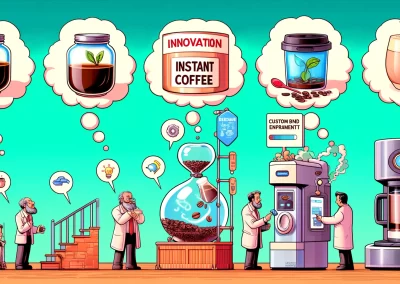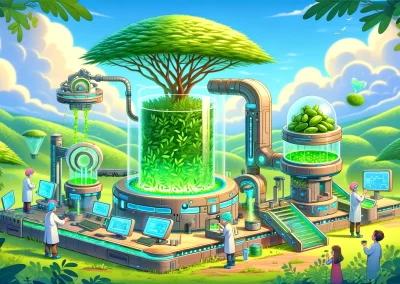For a lot of people, coffee is their energy booster to start the day. Do you ever wonder where does coffee come from? How is it harvested and how it gets to our daily lives? Read on for the answers!
Coffee beans come from Coffea genus plant. It is a small shrub or tree that can grow up to 10 meters (32ft) that bears fruit, inside this fruit is what we know as the coffee bean. Like any other plant, Coffea genus has different variety and each of this variety produces different kind and quality of coffee beans.
Coffea Genus
The coffee beans that we know are from a type of flowering plant. The coffee plant produces fruits and contains 1 or 2 green seeds which will become coffee beans. These green seeds are called coffee beans because of their appearance which resemble legumes and not because they are some time of vegetable.
The coffee plant which is Coffea, a genus of flowering plants that is from the family of Rubiaceae which has over 100 species of Coffea around the world. This plant is native to Eastern Africa and has a long history of how it became the 2nd largest traded commodity around the world.
Today, over 70 countries are cultivating coffee plants, primarily in the content of Asia, Africa and Americas.
Coffea Arabic is one of the most common species of coffee plant, which we know as Arabica, around 60-70% of Arabica are consumed all over the world. Next is the Coffea Canephora, which we know as Robusta. Around 30-40% of the Robusta beans are consumed around the world.
The species Coffea Liberica, known as Liberica which is consumed by less than 2% of the population, is an extinct bean with limited quantity and expensive price tag.
The coffee bean
Coffee plants can live up to 100 years, but they produce the most fruit with best tasting seeds around ages 7 and 20. The plant can take 3 to 4 years of growing before it starts to flower and another year or two before it produces fruits. Once the plant is producing fruits, you can harvest them and take the seeds. A single tree can produce 4.5 kg (10 pounds) fruits in a year.
Before you can get the wonderful coffee beans, these fruits will undergo a rigorous process which will make them ready for roasting, which then produces our beloved coffee beans.
Roasting the green seeds is an important process that will impact the flavor of the coffee beans. This process will create chemical reactions that will eliminate the earthy, grassy and hay-like flavor from the green seeds and will give us the aromatic flavor that we enjoy.
Coffee beans contain concentrated caffeine which gives a stimulating effect and all coffee has this naturally because the coffee plant uses this as a natural pesticide which protects its leaves and fruits from pests. The bitterness of caffeine is known to be toxic to bugs and insects.
Caffeine is also present in the coffee flower which attracts bees with its memorable smell, which is great for pollination.
Coffee is popular because of its amazing and aromatic smell, and the caffeine that gives people a boost to start their day.
Coffee Plant
The coffee plant is a tree that can typically grow up to 10 meters (32 ft) but farmers usually prune their plants at around 2 meters to conserve their energy and makes harvesting of fruits easier. Below are common characteristics of coffee plants, particularly the species Arabica.
Branches and leaves
Along the vertical stem of the coffee plant, horizontal branches grow in opposite directions. These branches grow leaves which are usually waxy and dark green, but in variety, these leaves can be purple or yellow.
These leaves can be 2 – 40 cm long and grows in pairs which are opposite of one another.
Flowers
White flowers are produced in cluster from the buds that form in the branches that produces an aromatic smell. A farmer has to wait around 3 to 4 years before a coffee plant starts producing white flowers.
Fruits
The fruit of the coffee plant grows in cluster where the flowers are located. Fruits begin to grow after a year or two after the coffee plant has started flowering. It’s as small as a small grape, from green, it turns red to yellow to orange that indicates it is ripe and is ready for harvesting. The outer layer can be eaten and has a sweet taste and pleasant acidity.
Commonly referred to as coffee cherry or red berries, the coffee fruit is usually disposed in most farms during their process, although some dry them and make cascara, a fruity infusion.
Seeds
Each coffee cherry produces 1 or 2 coffee seeds or as we refer to as coffee beans. Although most cherries produce two seeds, there are some that only contain 1 seed and this is called peaberry. Since two seeds are produced, one is flat and the other one is convex, which is usually the case.
Where does the coffee plant grow?
Coffee plants are usually farmed and grown in elevated place due to a more stable climate. These plants dislike direct sunlight and heavy rainfall. Coffee plants thrive in countries that have distinct dry and rainy season which provides moisture to new seedlings.
Arabica plants are farmed at higher places, usually 1000-2000 meter above sea level due to the cooler climate and fewer pests. While Robusta likes warmer climates, it thrives at lower elevations, typically 200-600 meters above sea level.
Which is better, Arabica or Robusta?
While Robusta is easier to grow, Arabica is far tastier over the two.
Arabica beans have a good balance of sweetness and bitterness since it contains more sugar. It also has a lower level of caffeine which means it is less bitter than Robusta. Coffee that is cultivated and farmed at a higher altitude produces a more complex taste and the higher it grows, the tastier it will be.
Brazilian Arabica which has a chocolaty and nutty flavor is grown at the lower end of the spectrum which has lesser acidity and is identified as a good-quality coffee. In countries like, Columbia, Ethiopia and Columbia, Arabica is farmed as high as 2000 meter above sea level which produces floral-tasting with fruity notes that is sweeter and has great acidity.
Despite tasting better, Robusta remains popular as it is more resistant to plant disease and pests making it easier to grow.
Robusta has earthy, woody and rubbery taste and tobacco-type notes with little to no acidity. This variety is mostly used in producing instant coffee and different coffee blends. Robusta is also used for espresso because of its crema production.
Crema is essential for cappuccino and with other drinks. It is also heavily advertised by Nescafé for their Nespresso brand.
Conclusion
If you want to know more about coffee and how to identify which is a good and high-quality coffee, start by searching for café’s in your local area that specializes in serving high quality coffee. Read more about different variety of coffee, and learn about their different characteristics and taste. Learn about their history and where they come from. Equip yourself with knowledge and then go on a journey of tasting coffee without any sugar or creamer, just coffee, and you might be surprised on how each one taste differently.









